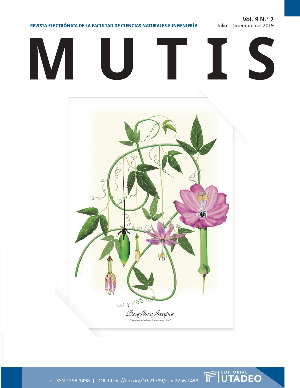Esta obra está bajo una licencia internacional Creative Commons Atribución-NoComercial-CompartirIgual 4.0.
Resumen
La astaxantina es un carotenoide y antioxidante utilizado en la industria cosmética, farmacéutica y alimentaria. Se produce naturalmente en la microalga H. pluvialis cuando esta crece bajo efecto de factores de estrés, como la deficiencia de nutrientes y una irradiancia alta, entre otros. Por lo anterior, se propone como objetivo de esta investigación determinar la producción de astaxantina y la expresión de los genes relacionados con su biosíntesis bajo condiciones de estrés por deficiencia de nitrógeno (4,0 y 5,0 %) y una irradiancia alta. Para este trabajo se realizó un cultivo en medio rm con nitrógeno a 4,0 y 5,0 %, utilizando las siguientes condiciones: pH 6,7; ciclo luz/oscuridad 20 h: 4 h; temperatura 25 ºC; agitación continua; CO2 de 5 %; iluminación con lámparas fluorescentes blancas (Tlt 20w/54rs marca Philips); e irradiancia alta de 140 µE. Adicionalmente, se utilizó como control el crecimiento en el medio con nitrógeno en concentraciones normales bajo las mismas condiciones durante 36 días. El muestreo se realizó cada tercer día para cuantificación de astaxantina y clorofila y determinación de expresión de genes. El anova realizado estableció que no hay diferencias significativas entre los tratamientos (P = 0,053). Sin embargo, la producción de astaxantina fue de 3,52x10-6 µg cel-1 x mL-1 con una concentración de nitrógeno al 4,0 % y una irradiancia alta de 140 µE, incrementándose en 40 % frente a la producción obtenida con nitrógeno al 5,0 % (2,08x10-6 ug cel-1 x mL-1). Los genes psy, pds, lcy, bkt y chy, se expresaron con nitrógeno al 4,0 %, mientras que con nitrógeno al 5,0 % solo se expresaron psy, pds y chy.
Citas
American Public Health Association [APHA] (1992). AWWA and WEF: Standard Methods for the Examination of Water and Wastewater (18th Ed.). Washington D. C.: American Public Health Association/American Water Works Association and Water Environment Federation.
Armenta, R. E., Guerrero-Legarreta, I., & Huerta, S. (2002). Extracción de caroproteinas a partir de residuos de camarón fermentados. Revista mexicana de ingeniería química, 1(1-2), 49-55.
Baranyi, J., & Roberts, T. A. (1994). A dynamic approach to predicting bacterial growth in food. International journal of food microbiology, 23(3-4), 277-294. https://doi.org/10.1016/0168-1605(94)90157-0
Boussiba, S., & Vonshak, A. (1991). Astaxanthin accumulation in the green alga Haematococcus pluvialis. Plant and cell Physiology, 32(7), 1077-1082. https://doi.org/10.1093/oxfordjournals.pcp.a078171
Brinda, B. R., Sarada, R., Kamath, B. S., & Ravishankar, G. A. (2004). Accumulation of astaxanthin in flagellated cells of Haematococcus pluvialis–cultural and regulatory aspects. Current Science, 1290-1295. https://www.jstor.org/stable/24109449
Candelas-Cadillo, M. G., Alanís-Guzmán, M. G. J., Bautista-Justo, M., Del Río-Olague, F., & García-Díaz, C. (2005). Contenido de licopeno en jugo de tomate secado por aspersión. Revista Mexicana de Ingeniería Química, 4(3), 299-307.
Cerón, M. C. (2013). Producción de microalgas con aplicaciones nutricionales para humanos y animales. Cuadernos de estudios agroalimentarios, 87(5), 83-101.
Chavarro-Mesa, E. (2011). Variabilidad genética y detección molecular de poblaciones del hongo Rhizoctonia solani en regiones colombianas productoras de papa (tesis de maestría). Universidad Nacional de Colombia, Bogotá.
Cifuentes, A. S., Gonzalez, M. A., Vargas, S., Hoeneisen, M., & Gonzalez, N. (2003). Optimization of biomass, total carotenoids and astaxanthin production in Haematococcus pluvialis Flotow strain Steptoe (Nevada, USA) under laboratory conditions. Biological Research, 36(3-4), 343-357. https://doi.org/10.4067/S0716-97602003000300006
Córdoba-Castro, N. M., Acero-Reyes, N. L., Duque-Buitrago, L. F., Jiménez-Aguilar, L. J., Serna-Jiménez, J. A. (2015). Obtención y caracterización de astaxantina de la microalga Haematococcus Pluvialis. UG Ciencia, 21, 73-82. https://doi.org/10.18634/ugcj.21v.1i.426
Domínguez-Bocanegra, A. R., Legarreta, I. G., Jerónimo, F. M., & Campocosio, A. T. (2004). Influence of environmental and nutritional factors in the production of astaxanthin from Haematococcus pluvialis. Bioresource technology, 92(2), 209-214. https://doi.org/10.1016/j.biortech.2003.04.001
Fábregas, J., Domínguez, A., Álvarez, D. G., Lamela, T., & Otero, A. (1998). Induction of astaxanthin accumulation
by nitrogen and magnesium deficiencies in Haematococcus pluvialis. Biotechnology Letters, 20(6), 623-626. https://doi.org/10.1023/A:1005322416796
Gong, X., & Chen, F. (1998). Influence of medium components on astaxanthin content and production of Haematococcus pluvialis. Process Biochemistry, 33(4), 385-391. https://doi.org/10.1016/S0032-9592(98)00003-X
González, M. A., Cifuentes, A. S., & Gómez, P. I. (2009). Crecimiento y contenido total de carotenoidesen cuatro cepas chilenas de Haematococcus pluvialis flotow, bajo condiciones de laboratorio. Gayana. Botánica, 66(1), 58-70. https://doi.org/10.4067/S0717-66432009000100006
Grünewald, K., Eckert, M., Hirschberg, J., & Hagen, C. (2000). Phytoene desaturase is localized exclusively in the chloroplast and up-regulated at the mRNA level during accumulation of secondary carotenoids in Haematococcus pluvialis (Volvocales, Chlorophyceae). Plant Physiology, 122(4), 1261-1268. https://doi.org/10.1104/pp.122.4.1261
Huang, J. C., Chen, F., & Sandmann, G. (2006). Stress-related differential expression of multiple β-carotene ketolase genes in the unicellular green alga Haematococcus pluvialis. Journal of biotechnology, 122(2), 176-185. https://doi.org/10.1016/j.jbiotec.2005.09.002
Imamoglu, E., Dalay, M. C., & Sukan, F. V. (2009). Influences of different stress media and high light intensities on accumulation of astaxanthin in the green alga Haematococcus pluvialis. New biotechnology, 26(3-4), 199-204. https://doi.org/10.1016/j.nbt.2009.08.007
Imamoglu, E., Vardar, F., Sukan, M., & Dalay, C. (2007). Effect of Different Culture Media and Light Intensities on Growth of Haematococcus pluvialis. International Journal of Natural and Engineering Sciences, 1(3), 5-9.
Kang, C. D., An, J. Y., Park, T. H., & Sim, S. J. (2006). Astaxanthin biosynthesis from simultaneous N and P uptake by the green alga Haematococcus pluvialis in primary-treated wastewater. Biochemical Engineering Journal, 31(3), 234-238. https://doi.org/10.1016/j.bej.2006.08.002
Kobayashi, M., Kakizono, T., & Nagai, S. (1993). Enhanced carotenoid biosynthesis by oxidative stress in acetate-induced cyst cells of a green unicellular alga, Haematococcus pluvialis. Applied and Environmental Microbiology, 59(3), 867-873. https://doi.org/10.1128/AEM.59.3.867-873.1993
Kurmen, J. E. C., González, G., & Klotz, B. (2013). Producción de Astaxantina en Haematococcus pluvialis bajo diferentes condiciones de estrés. Nova, 11(19), 93-104. https://doi.org/10.22490/24629448.1022
Luna, L. G., Menéndez, J., Álvarez, I., & Flores, I. (2009). Efecto de diferentes protocolos de aplicación de un campo magnético (0.03 T) sobre el crecimiento, viabilidad y composición pigmentaria de Haematococcus pluvialis Flotow en suficiencia y ausencia de nitrógeno. Biotecnología vegetal, 9(2), 105-117.
Martínez-Silva, A. S. (2011). Evaluación del crecimiento celular y de los pigmentos obtenidos de la microalga Haematococcus pluvialis (Chlorophyta: Volvocales) cultivada en diferentes medios (Disertación doctoral). Instituto Técnico Nacional, Ciudad de México, México.
Mendoza, N. M., Jaramillo, C. A., Guhl, F., Padilla, J. C., & Rentería, M. C. (2001). Diagnóstico de malaria por el método de la PCR anidada. Biomédica, 21(4), 320-327. https://doi.org/10.7705/biomedica.v21i4.1124
Niño-Castillo, C. M., Rodríguez-Rivera, F. C., Díaz, L. E., & Lancheros-Díaz, A. G. (2017). Evaluation of Cell Growth Conditions for the Astaxanthin Production as of Haematococcus pluvialis Microalgae. Nova, 15(28), 19-31. https://doi.org/10.22490/24629448.2073
Nunes, M., Vieira, A. A. H., Pinto, E., Carneiro, R. L., & Monteiro, A. C. (2013). Carotenogenesis in Haematococcus pluvialis cells induced by light and nutrient stresses. Pesquisa Agropecuária Brasileira, 48(8), 825-832. https://doi.org/10.1590/S0100-204X2013000800003
Orosa, M., Franqueira, D., Cid, A., & Abalde, J. (2005). Analysis and enhancement of astaxanthin accumulation in Haematococcus pluvialis. Bioresource Technology, 96(3), 373-378. https://doi.org/10.1016/j.biortech.2004.04.006
Ponce-Palafox, J. T., Arredondo-Figueroa, J. L., & Vernon-Carter, E. J. (2006). Carotenoids from plants used in diets for the culture of the pacific white shrimp (Litopenaeus vannamei). Revista Mexicana de Ingeniería Química, 5(2), 157-165.
Qiagen (2011). RT2 Easy First Strand Handbook, For cDNA synthesis. Qiagen
Ramírez-Landínez, D. M. (2013). Evaluación del crecimiento y producción de astaxantina por Haematococcus pluvialis en un fotobiorreactor tipo airlift (tesis de maestría). Universidad Nacional de Colombia, Bogotá.
Richmond, A. (Ed.). (2008). Handbook of microalgal culture: biotechnology and applied phycology. John Wiley & Sons.
Sarada, R., Tripathi, U., & Ravishankar, G. A. (2002). Influence of stress on astaxanthin production in Haematococcus pluvialis grown under different culture conditions. Process Biochemistry, 37(6), 623-627. https://doi.org/10.1016/S0032-9592(01)00246-1
Scibilia, L., Girolomoni, L., Berteotti, S., Alboresi, A., & Ballottari, M. (2015). Photosynthetic response to nitrogen starvation and high light in Haematococcus pluvialis. Algal Research, 12, 170-181. https://doi.org/10.1016/j.algal.2015.08.024
Steinbrenner, J., & Linden, H. (2001). Regulation of two carotenoid biosynthesis genes coding for phytoene synthase and carotenoid hydroxylase during stress-induced astaxanthin formation in the green alga Haematococcus pluvialis. Plant physiology, 125(2), 810-817. https://doi.org/10.1104/pp.125.2.810
Steinbrenner, J., & Sandmann, G. (2006). Transformation of the green alga Haematococcus pluvialis with a phytoene desaturase for accelerated astaxanthin biosynthesis. Applied and environmental microbiology, 72(12), 7477-7484. https://doi.org/10.1128/AEM.01461-06
Torzillo, G., Göksan, T., Isik, O., & Gökpinar, Ş. (2005). Photon irradiance required to support optimal growth and interrelations between irradiance and pigment composition in the green alga Haematococcus pluvialis. European Journal of Phycology, 40(2), 233-240. https://doi.org/10.1080/09670260500123609
Vidhyavathi, R., Venkatachalam, L., Sarada, R., & Ravishankar, G. A. (2008). Regulation of carotenoid biosynthetic genes expression and carotenoid accumulation in the green alga Haematococcus pluvialis under nutrient stress conditions. Journal of Experimental Botany, 59(6), 1409-1418. https://academic.oup.com/jxb/article-abstract/59/6/1409/485379 https://doi.org/10.1093/jxb/ern048
Vidhyavathi, R., Sarada, R., & Ravishankar, G. A. (2009). Expression of carotenogenic genes and carotenoid production in Haematococcus pluvialis under the influence of carotenoid and fatty acid synthesis inhibitors. Enzyme and Microbial Technology, 45(2), 88-93. https://doi.org/10.1016/j.enzmictec.2009.05.005
Wan, M., Zhang, J., Hou, D., Fan, J., Li, Y., Huang, J., & Wang, J. (2014). The effect of temperature on cell growth and astaxanthin accumulation of Haematococcus pluvialis during a light-dark cyclic cultivation. Bioresource technology, 167, 276-283. https://doi.org/10.1016/j.biortech.2014.06.030
Wang, J., Sommerfeld, M. R., Lu, C., & Hu, Q. (2013). Combined effect of initial biomass density and nitrogen concentration on growth and astaxanthin production of Haematococcus pluvialis (Chlorophyta) in outdoor cultivation. Algae, 28(2), 193-202. https://doi.org/10.4490/algae.2013.28.2.193
Descargas
Datos de publicación
Perfil evaluadores/as N/D
Declaraciones de autoría
- Sociedad académica
- Universidad de Bogotá Jorge Tadeo Lozano
- Editorial
- Universidad de Bogotá Jorge Tadeo Lozano

 PDF
PDF
 FLIP
FLIP
 XML
XML













